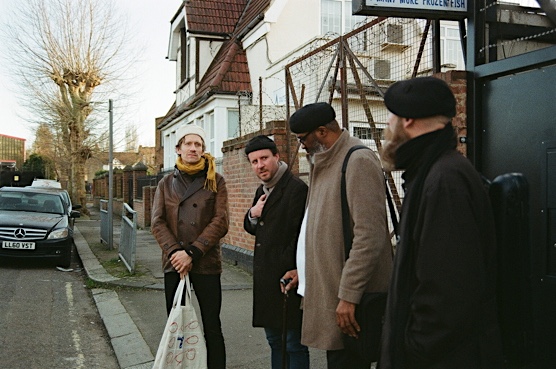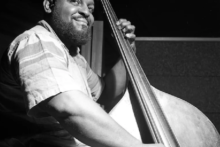Experiencing [Ahmed] in full flow is a glorious thing, as the band locks into a dense texture of squeaking saxophone, explosive piano clusters, pulsing bass and locomotive drums. It’s repetitious yet constantly evolving, sending crowds into the kind of frenzy associated with club music as much as jazz or improvisation. [Ahmed] aren’t interested in fusion or hybrids, but their state-of-the-art acoustic jazz is informed by the way masters from Count Basie to Jah Shaka, M-Beat to RP Boo organise sound and move bodies. As drummer Antonin Gerbal, fluent in swing-era repertoire from working with the Umlaut Big Band, puts it, “who says free music can’t dance?”
Rhythm is at the heart of what they do, with their collective sound emphasising interplay over solos. Seymour Wright pointedly eschews saxophone heroics for nagging motifs and reedy microtonal phrases, while pianist Pat Thomas stokes the engine from the centre of the keyboard, and bassist Joel Grip builds a pulse over Gerbal’s relentless swing. Like The Necks or Natural Information Society, [Ahmed] explore trance states through the vocabulary of jazz and improvised music, but they do it with much greater intensity and speed. If you’ve been moved by Sons of Kemet or Ezra Collective’s carnival propulsion but want something that goes much further out, then [Ahmed] could be the answer.
To date, [Ahmed]’s albums have all been live recordings, showcasing compositions by jazz visionary Ahmed Abdul-Malik. Sama’a (Audition) is their first studio session, with the quartet recreating the programme of Abdul-Malik’s 1959 album Jazz Sahara. A bassist and oudist who played with Thelonious Monk and John Coltrane, Abdul-Malik released a series of innovative albums between 1959 and 1964 fusing bebop and modal jazz with African and Arabic music, incorporating non-western instruments into the texture. A practicing Sufi, Thomas views Abdul-Malik’s work as a radical attempt by a Black American musician to reconnect with the pan-Islamic tradition passed down by his ancestors through jazz and blues. In using Abdul-Malik’s music as a springboard for improvisation, [Ahmed] create vital new music that is the antithesis of conservative museum jazz.
While previous recordings have featured epic readings of a single tune, the four pieces of Sama’a weigh in between fourteen and nineteen minutes. If anything, the more condensed approach brings even greater focus and intensity, with the studio setting bringing enhanced sonic clarity and allowing for different kinds of dialogue and development to a live show. While there are no extended solos, duo and trio exchanges allow [Ahmed] to open up new dimensions in the material. While earlier recordings, such as 2021’s Nights On Saturn, begin as relatively straight readings of the original melody and groove, Sama’a sees [Ahmed] making radical choices in their interpretation of the material.
‘Ya Annas (Oh People)’ opens with a signature Wright honk, followed by a braying multiphonic that climbs to keening altissimo. It can be heard as an abstraction of Johnny Griffin’s unaccompanied tenor sax introduction on the original, but where Abdul-Malik has the full band come in behind him, here it’s Grip who picks up the theme, his bowed bass building on the microtonal architecture of Naim Karacand’s retuned violin. Wright comes back in with overtone-rich drones, with Grip’s rhythmic motif setting up Thomas and Gerbal’s entry. The quartet works that groove for several minutes, with Thomas’s jabbing chords and Gerbal’s loping drums holding the space for Wright’s pinched enquiries and Grip’s quicksilver licks. Over time the swing gives way to a harder rhythmic attack and denser texture, with Wright worrying away at a single note while Thomas constructs a Giant’s Causeway of piano clusters. Rather than go full pelt, [Ahmed] take an elastic approach to dynamics and tempo, with a Grip and Gerbal duo feature opening up space for exploratory group dialogue in the closing minutes. Holding down the sustain pedal, Thomas’s basaltic columns crumble into the sea, while Wright takes it out with cool jazz meditations.
Grip and Gerbal kick off ‘Isma’a (Listen)’ with nearly three minutes of unaccompanied bass and drums. One of the great rhythm sections of our time, they move with a single purpose, the bass establishing a tonal centre and pulse while Gerbal slaps and rolls the toms with the relish of an old school swing drummer. As a member of the Umlaut Big Band, Gerbal has mastered the art of putting a contemporary spin on pre-bop forms, and his playing here is truly orchestral and polyrhythmic, taking Wright on a high speed chase as he introduces then deconstructs the melody over Thomas’s pounding clusters. Gerbal’s kick drum goes like a steam hammer, finding the sweet spot between Louis Bellson’s exhilarating solo on Duke Ellington’s ‘Skin Deep’ and heavy metal blast beats. Riding the band’s relentless forward motion, Wright spits, sputters and squalls before confidently returning to the melody, his legato projecting a calmness while the drums simmer away. A gutsy bass solo sets up a superhuman drum outro: this is exhilarating music.
‘El Haris (Anxious)’ has been a staple of the [Ahmed] repertoire from the very beginning, but this latest version takes the composition to different places from 2017’s New Jazz Imagination or last year’s Giant Beauty. Thomas and Wright are the featured duo this time, negotiating an abstract soundworld of prepared piano clunks, mouthpiece pops and key taps. Fragments of the melody slowly come into view, with Wright alternating between gleaming licks and sustained multiphonics. Grip’s spiccato bowing fuses with Thomas’s tremolo chords to create a dense thrum from which the bassist carves out a rhythmic motif. The range of melodic, timbral and rhythmic effects [Ahmed] are able to achieve within this texture is remarkable.
On ‘Farah ‘Alaiyna’ (Joy Upon Us)’, they go right into the tune as on the original recording. But this being [Ahmed], it’s a little more angular and restless than Abdul-Malik and Karacand’s stately oud and violin arrangement. There’s a delicious push and pull between the rhythm section’s emphasis on the swing and Wright’s raspy altissimo, before the classic [Ahmed] move of locking in then spinning out in multiple directions. Wright offers some of his most beautiful playing here, from a sensitive reading of the melody around the ten-minute mark to the long tones he folds into the shimmering conclusion.
Sama’a is the sound of a band at the peak of their powers, their spontaneous interplay, invention and commitment undimmed. In the music of Ahmed Abdul-Malik they’ve found an infinite universe.




